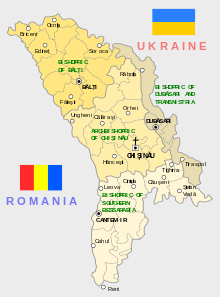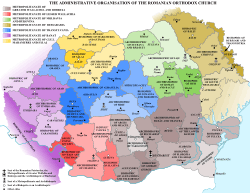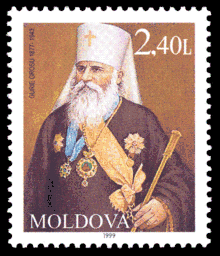Metropolis of Bessarabia
The Metropolis of Bessarabia (Romanian: Mitropolia Basarabiei), also referred to as the Bessarabian Orthodox Church,[1] is a Moldovan autonomous Eastern Orthodox Metropolitan bishopric of the Romanian Orthodox Church. Its canonical jurisdiction is the territory of the Republic of Moldova, and over the Moldovan and Romanian Orthodox diaspora from the former USSR.[2]
Metropolis of Bessarabia | |
|---|---|
 Organization of the Metropolis of Bessarabia | |
| Location | |
| Territory | |
| Headquarters | Chișinău |
| Statistics | |
| Population - Total | 720,000 |
| Information | |
| Denomination | Eastern Orthodox |
| Sui iuris church | Romanian Patriarchate (Autonomous Metropolis) |
| Established | 1918 |
| Language | Romanian |
| Current leadership | |
| Bishop | Petru (Păduraru) |
| Website | |
| mitropoliabasarabiei.md | |

The Metropolis of Bessarabia was created in 1918, as the Archbishopric of Chișinău, and organized as a Metropolis, in 1927.[3] Inactive during the Soviet occupation of Bessarabia (1940-1941) and the Soviet rule in Moldova (1944-1991), the Metropolis of Bessarabia was re-activated on 14 September 1992, and raised to the rank of exarchate, in 1995. The current Metropolitan of Bessarabia is Petru (Păduraru).[4]
History
In 1812, after the annexation of Bessarabia by the Russian Empire, the Orthodox churches were re-organized as the Eparchy of Chişinău and Hotin, from the churches and monasteries of the Metropolis of Moldavia on that territory that no longer belonged to the Principality of Moldavia, by Gavril Bănulescu-Bodoni, a popular promoter of Moldavian/Romanian language and culture, who also served as its first Archbishop. After 1821, the Russian state and church started an extended policy of Russification.[5]
In 1858, after southern Bessarabia was returned to Moldavia, which soon united with Wallachia to form Romania, the Orthodox churches in Cahul, Bolgrad, and Ismail re-entered under the Romanian Church jurisdiction of the Metropolis of Moldavia, which established the Diocese of the Lower Danube, in 1864.[6] In 1878, after Russia re-annexed southern Bessarabia, the Russian Church jurisdiction was reinstated.
In 1918, after the Union of Bessarabia with Romania, the archbishop Anastasius Gribanovsky of the Eparchy of Chişinău was ousted after he refused to accede to Romania's demand to secede from the Russian Orthodox Church and integrate the eparchy in the Romanian one. With the advent of Greater Romania in 1918, there were three church bodies: the autocephalous Romanian Orthodox Church (on the territory of Smaller Romania—prior to 1918—formed in 1872 from the union of the Metropolis of Ungrovlahia with Metropolis of Moldavia), and the non-autocephalous Metropolis of Bessarabia and Metropolis of Transylvania. Therefore, in 1925, the rank of the Romanian Orthodox Church was raised to that of a Patriarchate, with the Metropolis of Bessarabia as one of its five sees. Gurie Grosu was the first Metropolitan of Bessarabia, and Efrem Enăchescu the second.
After the Soviet occupation of Bessarabia in 1940, the church, which then was a non-autonomous Metropolis, was banned, and its property has either changed uses, or was transferred to the Russian Orthodox Church, which established the Bishopric in Chişinău and Moldova. In 1980s, two more bishoprics were added, and the See raised to the status of the Archdiocese, in 1990, and as the Metropolis of Chișinău and All Moldova, in 1992.
After Moldova's independence in 1991, part of the clergy followed Petru Păduraru, the Bishop of Bălţi, and re-established the Metropolis of Bessarabia. The Romanian Orthodox Church considered that, during the time, the Russian Orthodox Church jurisdiction on the former territory of Bessarabia was an unfair and abusive act in terms of historical reality and canon law, and as long as it remains under the Russian Orthodox Church, the jurisdiction right of the Metropolis of Chișinău and All Moldova can be exercised only to the Russian ethnics of Moldova.[7]
The Russian Orthodox Church also refused to recognize the authority of the Bessarabian church, and the two metropolia started an uneasy co-existence. During the 1990s, the one subordinated to the Russian Orthodox Church gained the protection of the country's authorities and established itself as the official church, while the Orthodox Church of Bessarabia was refused registration according to the country's new law of religions. In 2004, after years of legal hurdles and a final decision by the European Court of Human Rights, the Orthodox Church of Bessarabia received official registration, the Supreme Court of Justice of the Republic of Moldova recognizing it as "the spiritual, canonical, historical successor of the Metropolitan See of Bessarabia which functioned till 1944, including".[8] About 20% of country's Orthodox churches were or changed to be under its jurisdictions; a strong desire to similar moves has been expressed in many other parishes.
This decision continues to be a major area of tension with the Russian Orthodox Church. The position of the Romanian Orthodox Church in the dispute with the Russian Orthodox Church over the territorial jurisdiction is, according to a press release, that the two Metropolitan Sees should "peacefully co-exist and brotherly cooperate (…) harmonising, with wisdom and realism, the territorial principle with the ethnic principle, as agreed in the pastoral service of the Orthodox in Diaspora."[8]
Structure and organization
The church is currently recognized only by some other Orthodox Churches, since the Patriarchate of Moscow opposes its recognition by all of them.[9] The current Metropolitan of Bessarabia is Petru Păduraru (born 24 October 1946 in Ţiganca, elected as metropolitan in 1992), and it has about one third of the orthodox community in Moldova.[10]
The Metropolis of Bessarabia consists of four eparchies:
- Archdiocese of Chișinău
- Diocese of Bălți
- Diocese of Southern Bessarabia
- Diocese of Dubăsari and Transnistria
See also
- History of the Orthodox Church in Moldova
- Religion in Moldova
- List of members of the Holy Synod of the Romanian Orthodox Church
- Metropolis of Moldavia and Bukovina
- St. Teodora de la Sihla Church
- Luminătorul
- Misionarul
Gallery
References
- International Religious Freedom Report 2007 about Moldova
- Mitropolia Ortodoxa Romana a Basarabiei at crestinortodox.ro
- "The Position of the Romanian Patriarchate concerning the Reactivation of the Three Dioceses in the Metropolitanate of Bessarabia". Archived from the original on 2014-02-22. Retrieved 2014-02-04.
- Administrative Organisation of the Romanian Orthodox Church Archived 2014-01-23 at the Wayback Machine at patriarhia.ro
- John Anthony McGuckin (15 December 2010). The Encyclopedia of Eastern Orthodox Christianity, 2 Volume Set. John Wiley & Sons. pp. 765–. ISBN 978-1-4443-9254-8.
- The Lower Danube Archidiocese history
- 19 mai 1993 - Scrisoarea Prea Fericitului Patriarh Teoctist către Sanctitatea Sa Alexei II (1993) (in Romanian)
- Press release: A legitimate act for defending the Romanian identity - Explanations concerning the juridical recognition of the Metropolitan See of Bessarabia and of the suffragan eparchies Archived 2008-02-27 at the Wayback Machine, Romanian Patriarchy, 21 February 2008. — "Archived copy" (PDF) (in French). Archived from the original (PDF) on 2008-02-27. Retrieved 2008-04-21.CS1 maint: archived copy as title (link) — "Archived copy" (in Romanian). Archived from the original on 2008-02-26. Retrieved 2008-04-21.CS1 maint: archived copy as title (link) — "Archived copy" (PDF) (in Russian). Archived from the original (PDF) on 2008-02-27. Retrieved 2008-04-21.CS1 maint: archived copy as title (link)
- Lucia Turcescu, Lavinia Stan, Church–state conflict in Moldova: the Bessarabian Metropolitanate (abstract)
- (in Romanian) "Înalt Prea Sfinţitul Vladimir vorbeşte despre unirea Mitropoliei Moldovei cu cea a Basarabiei" ("Metropolitan Vladimir about the union of the two Metropolitans in Moldova"), publika.md, 30 August 2013
External links
- Official website
- Website (in Romanian)
- Liberté de la Métropolie de la Béssarabie
- Freedom of the Metropolis of Bessarabia
- DECLARATION ECRITE N° 265 concernant l'arrêt de la Cour d'Appel de la République de Moldova relatif à la légitimité et à la liberté de la Métropolie de Bessarabie
- WRITTEN DECLARATION No. 265 on the decision of the Court of Appeal of the Republic of Moldova on the legitimacy and freedom of the Metropolis of Bessarabia
- Droit de l'Eglise métropolitaine de Bessarabie à sa propre succession juridique
- Right of the Metropolitan Church of Bessarabia to its own succession in title
- Complicité de la Patriarchie de Moscou et de toute la Russie avec le régime illégale et sécessioniste installé à l'Est de la République de Moldova
- Complicity of the Patriarch of Moscow and all Russia with the illegal and secessionist regime installed in the east of the Moldovan Republic
- Statement concerning the arguments of the representatives of the Romanian Orthodox Church justifying the decision to establish dioceses of the Metropolia of Bessarabia
- Territorial Jurisdiction According to Orthodox Canon Law. The Phenomenon of Ethnophyletism in Recent Years, a paper read at the International Congress of Canon Law, 2001, (Ecumenical Patriarchate website)
- Torna a Patriarcato di Mosca (in Italian)


